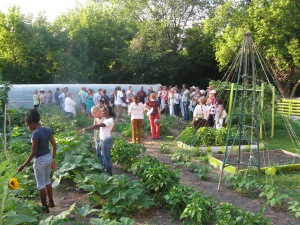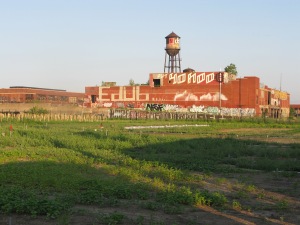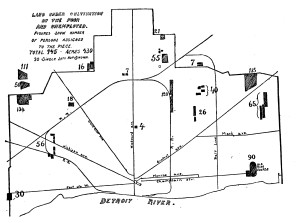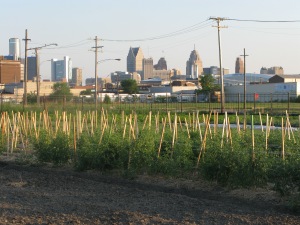Reflections on Landscapes, Archives, and History Part I
October 11, 2012 at 2:06 pm smithsoniangardens 4 comments
Back in the warmer days of August, I had the opportunity to attend the Detroit Agriculture Network’s 15th Annual urban garden tour in Detroit, Michigan. Hundreds of people gathered in the late afternoon at Eastern Market to board buses or take off on bikes to visit gardens and hear from gardeners on the east, west, and central areas of the city. Above all, it was an occasion to hear from passionate individuals and view the city from the ground up.

A garden tour stop at Manistique Community Garden on Detroit’s East Side
Image by Joe Cialdella
Even though my first experience seeing and volunteering with urban gardens in Detroit was in 2004, looking at the gardens in Detroit’s landscape – a compelling assortment of open space, roads, and buildings (many still inhabited and, yes, many long abandoned) – continues to be at once jarring and inspiring; a poignant and thought-provoking place because of the layers of time and meanings collected here. As garden historian Kenneth Helphand writes,
“When we see an improbable garden, we experience a shock of recognition of the garden’s form and elements, but also a renewed appreciation of the garden’s transformative power to beautify, comfort, and convey meaning despite the incongruity of its surroundings. Gardens are defined by their context, and perhaps the further the context from our expectations, the deeper the meaning the garden holds for us.”[1]
As a historian, the context I look to when I see these gardens is often that of the past. How did social, political, economic, environmental and cultural conditions shape transform these spaces? The seeming improbability of gardens as a part of post-industrial landscape challenged my expectations, and sparked my interest in learning what deeper meanings, and histories, gardening in Detroit might have.
Through this experience with a place, the landscape itself becomes an inspiration and an archive. A record of changing tastes, values, style, and use, for example, is captured by looking closely at the location, age, and size of buildings. Natural features, such as rivers and waterways often mark the original contribution to the archive of a landscape.
Yet in a place like Detroit, where seemingly endless redevelopment and decline are starkly juxtaposed, you cannot help but wonder what is missing from the landscape today. This can be particularly problematic when digging deeper into the history of such fleeting spaces as small scale community-minded gardens in a constantly changing urban environment.

Old and new features of the landscape meet where the Greening of Detroit’s “Detroit Market Garden” borders an industrial building.
Image by Joe Cialdella
Gone from Detroit’s landscape is the rich tradition of gardening culture that came before the contemporary movement. For example, during the 1890s, Mayor Hazen S. Pingree started a municipally-supported gardening plan to feed unemployed workers (many of whom were Polish and German immigrants). The Garden Club of Michigan was one of the 12 founding members of the Garden Club of America in 1913. During the Great Migration, African Americans moving to Detroit used gardens as a means of providing food and improving the appearance and value of their neighborhoods. And in the 1930s, thrift gardens again provided sustenance to many of those left unemployed by the Great Depression.
As the Haupt Fellow at Smithsonian Gardens, I’m in the process of digging up the details of these gardens using more traditional archives to better understand the history of what it means for people to contribute to an urban-industrial landscape by gardening. This can be a difficult task since the spaces themselves are often fleeting and records of them scarce, unlike many of the design plans and photographs of more famous landscapes. Looking back to the 19th and early 20th centuries, sociological surveys, government reports, meeting minutes, scrapbooks, maps, newspapers, magazines, and photographs are often surprisingly detailed documents that provide us with a way to re-imagine what these types of gardens looked like, their contexts, and how they were used in the past.

Map of “Pingree’s Potato Patches” from an 1894 government report
Together, the actual landscape and the two-dimensional records of experiences long removed from the land lend themselves to a fuller garden history that contributes not only to understanding gardens themselves, but also how gardens can reflect changing social, political, economic, environmental, and cultural contexts that give more people a way to consider the role of gardens and landscapes in their own lives.
The fleeting, seasonal nature of gardens also points to the importance of documenting garden spaces today. While we all hope they will last forever, proactively considering how you can preserve a garden or landscape’s history for your family, community, or organization provides an opportunity for reflection and sharing of information between one another that can often help to create connections and networks of support that will help these spaces exist into the future. One way of doing this is through creating a collection of photographs, such as those found in Smithsonian Gardens’ Archives of American Gardens. Look for more on this in my next post.

Tomato Plants and Detroit’s Skyline.
Image by Joe Cialdella
– Joe Cialdella, Haupt Fellow, Smithsonian Gardens
For more information on being a part of preserving garden history or beginning your own research, check out the resources below.
Take 10 minutes to “tag” an image form the Archives of American Gardens to help make their extensive collections more accessible to the public, researchers, and landscape designers!
These websites offer good tips and instructions for beginning your own archival adventure into the history of a garden or landscape near you:
http://www.williamcronon.net/researching/landscapes.htm
http://envhist.wisc.edu/cool_stuff/landscapetips.shtml
http://www.ultimatehistoryproject.com/early-detection.html
[1] Kenneth Helphand. Defiant Gardens: Making Gardens in Wartime, 2006, pg. 9.
Entry filed under: Archives of American Gardens, Collections, Education, Garden History. Tags: American Archives Month, community gardens, cultural landscapes, Detroit, history, urban gardens.
4 Comments Add your own
Leave a comment
Trackback this post | Subscribe to the comments via RSS Feed

1. cylka | January 6, 2013 at 2:35 pm
cylka | January 6, 2013 at 2:35 pm
Can you give me the full citation for the Pingree Potato Patch map?
I would like to see a larger image. Thank you!
2. Joe C. | January 7, 2013 at 8:35 am
Joe C. | January 7, 2013 at 8:35 am
The map is from “Report of the Agricultural Committee,” Detroit, Mich.1895 and 1896. It has been digitized and is available as a PDF on Google Books or through the University of Michigan library.
http://books.google.com/books?id=fgvlAAAAMAAJ&pg=PP1#v=onepage&q&f=false
3. Archives, landscapes, and History Part II: The Lens of Garden History « Smithsonian Gardens | November 1, 2012 at 11:25 am
Archives, landscapes, and History Part II: The Lens of Garden History « Smithsonian Gardens | November 1, 2012 at 11:25 am
[…] Click here to read part I […]
4. Beth Whitney | October 13, 2012 at 5:46 pm
Beth Whitney | October 13, 2012 at 5:46 pm
Great blog, Joe! I look forward to reading more…Beth Whitney